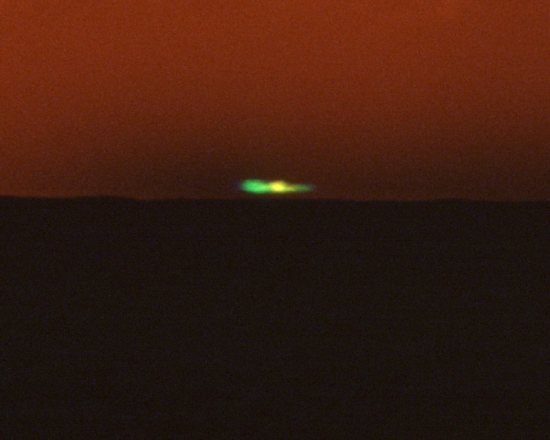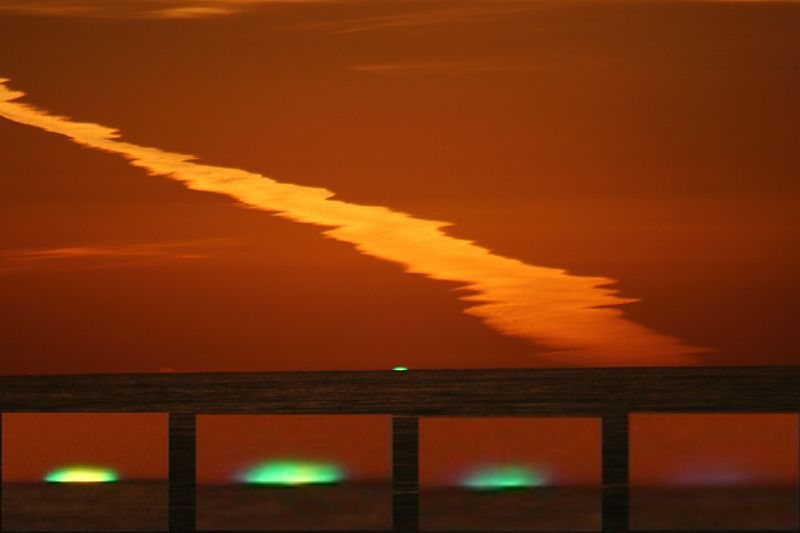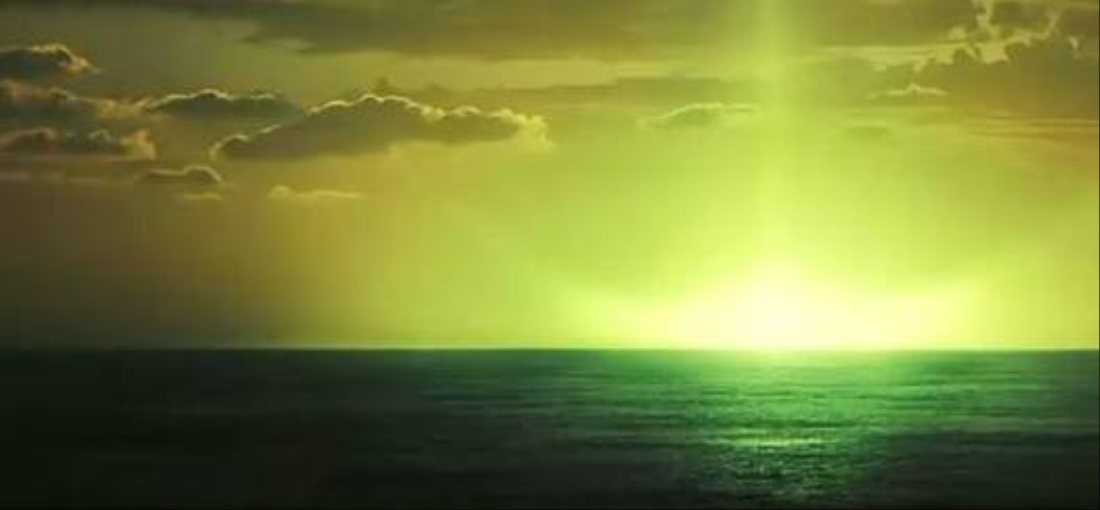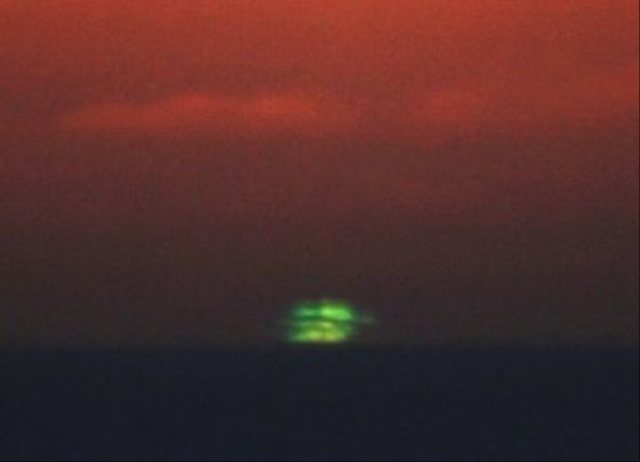Green Flash
If we are to believe the old legend that Jules
Verne recounts in his novel The Green Flash, it is a magic light ray that endows
those who are lucky enough to see one with the power to look deeply into their
own heart and recognise true love. Well, seeing a green flash may not bring you
heightened powers of self knowledge, but its existence is not just a myth,
either. We have been lucky enough to see two this week.
 
A Green Flash as
opposed to all you saddos that thought I meant Green
Flash.
Green flashes and green rays are optical
phenomena that occur shortly
after sunset or before sunrise, when a green spot is visible for a short period of
time above the sun, or a green ray shoots up from the sunset point. Green
flashes are actually a group of phenomena stemming from different causes, and
some are more common than others. Green flashes can be
observed from any altitude (even from an aircraft). They are usually seen at an
unobstructed horizon, such as over the ocean, but are possible over cloud-tops and mountain-tops as
well.
Explanation
The reason for a green flash lies in
refraction of light (as in a prism) in the atmosphere: light moves more slowly in the lower, denser air than
in the thinner air above, so sunlight rays follow paths that curve slightly, in
the same direction as the curvature of the Earth. Higher frequency light (green/blue) curves more than
lower frequency light (red/orange), so green/blue rays from the upper limb of
the setting sun remain visible after the red rays are obstructed by the
curvature of the earth. Green flashes are enhanced by
mirage, which increase the density gradient in the atmosphere,
and therefore increase refraction. A green flash is more likely to be seen in
clear air, when more of the light from the setting sun reaches the observer
without being scattered. We might expect to see a
blue flash, but the blue is preferentially scattered out of
our line of sight and remaining light ends up looking
green. With slight
magnification a green rim on the top limb of the solar
disk can be seen on most clear-day sunsets. However the
flash or ray effects require a stronger layering of the atmosphere and a
mirage which serves to magnify the green for a fraction of a
second to a couple of seconds.
Blue flashes - Very occasionally, the
amount of blue light is sufficient to be visible as a "blue
flash". The term should not be
confused with the similar usage of blue flash referring to the blue light seen in nuclear
accidents.
Green rim

Upper rim is
green and lower rim is red while the sun is setting behind the Golden Gate Bridge
As an astronomical object sets or rises, the light it emits travels through the
atmosphere, which works as a
prism separating the light
into different colors. The colour of the upper limb of an astronomical
object could go from blue to
green to violet depending on the decrease in concentration of
pollutants as they spread
throughout an increasing volume of atmosphere. The lower limb of an
astronomical object is always red.
A
green rim is very thin, and is difficult or impossible to see with the naked
eye. In usual conditions a green rim of an astronomical object gets fainter, when an astronomical
object is very low above the
horizon because of
atmospheric
reddening, but sometimes the
conditions are right to see a green rim just above the horizon. The following quote describes probably the longest
green rim, which at times could have been a green flash, observation. It was
seen on and off for 35 long minutes by members of the Richard Evelyn
Byrd party from the Little
America exploration base. Often a
green rim changes to a green flash and back again during the same
sunset.
Green flashes in fiction

The green flash in Pirates of
the Caribbean: At World's End
This phenomenon features as a major plot device in the
Disney's film Pirates of the
Caribbean: At World's End. In
the movie's back story, the green flash is fictionalized, becoming an occurrence
of legendary quality that is rumored to signify a soul returning from the dead.
Later in the film, this concept is further expanded, and the flash is revealed
to signal when a trapped spirit escapes from its imprisonment in Davy Jones's
Locker, a feat achieved by the
film's main characters. However, the size and scale of the flash depicted in the
film is greatly exaggerated.
This phenomenon is also referred to in a novel called The Green
Ray by Jules
Verne - outlined above, a novel called Smith and the Pharoahs by H. Rider Haggard,
a novel called Don't Stop the Carnival
by Herman Wouk . The green flash is also briefly mentioned in M. K.
Wren's "A Gift upon the
Shore", a mythic story
of survival after a nuclear holocaust. In the book Flush seeing the green flash is described as a family goal.
In the book The Pride and the Peacock
by Victoria Holt, a large opal named
"The Green Flash at Sunset" is the titular treasure. The opal is so named due to
a glint of green that may be rarely seen in certain light and at a certain angle
to the gem. In a film by Eric Rohmer called Le rayon
vert and a 2008
film directed by Paul Nihipali, Green Flash.

ALL IN
ALL it doesn't strike me very much
because I can't see it, cos of my red/green sight impairment, sad for you, it's amazing.
|





